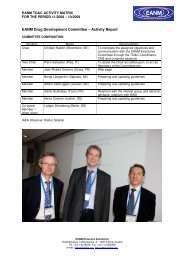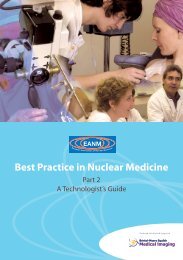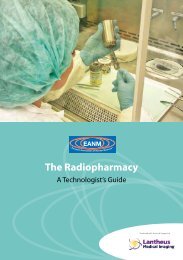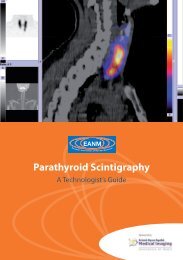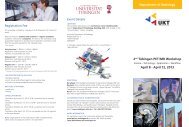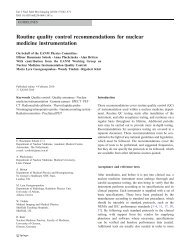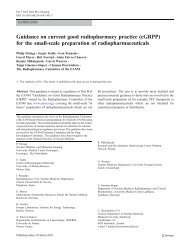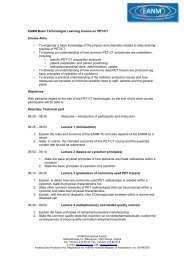Parathyroid Scintigraphy - European Association of Nuclear Medicine
Parathyroid Scintigraphy - European Association of Nuclear Medicine
Parathyroid Scintigraphy - European Association of Nuclear Medicine
Create successful ePaper yourself
Turn your PDF publications into a flip-book with our unique Google optimized e-Paper software.
1a) is defined by a fixed distance from the axis<br />
<strong>of</strong> rotation to the centre <strong>of</strong> the camera surface<br />
for all angles. Elliptical orbits (Fig. 1b) follow<br />
the body outline more closely.<br />
Figure 1a Figure 1b<br />
Figure 1a circular orbit<br />
Figure 1b elliptical orbit<br />
With a circular orbit, the camera is distant from<br />
the body at some angles, causing a reduction<br />
in spatial resolution in these projections. This<br />
will reduce the resolution <strong>of</strong> the reconstructed<br />
images.<br />
With an elliptical orbit, spatial resolution will be<br />
improved as the camera passes closer to the<br />
body at all angles. Nevertheless, the distance<br />
from the organ to the detector varies more<br />
significantly with an elliptical orbit than with<br />
a circular orbit. This may generate artefacts<br />
simulating small photopenic areas when reconstructing<br />
using filtered back projection.<br />
Programmes that allow the camera to learn<br />
and closely follow the contours <strong>of</strong> the body<br />
1<br />
Chapter 3: Imaging equipment - preparation and use<br />
are available and improve resolution, although<br />
at the expense <strong>of</strong> computing power to modify<br />
the data before reconstruction.<br />
The loss <strong>of</strong> spatial resolution with a circular<br />
orbit has to be <strong>of</strong>fset against the potential artefacts<br />
that may be generated by an elliptical<br />
or contoured orbit.<br />
Filtered back projection image<br />
reconstruction: some considerations<br />
The main goal <strong>of</strong> nuclear medicine parathyroid<br />
imaging procedures is to identify the<br />
site <strong>of</strong> parathyroid hormone production,<br />
usually a single parathyroid adenoma. However,<br />
parathyroid adenomas can be found in<br />
diverse locations: alongside, beside or within<br />
the thyroid, or in anatomical regions distant<br />
from thyroid, such as high or low in the neck<br />
and mediastinum. The diversity <strong>of</strong> these anatomical<br />
locations makes SPECT a useful tool<br />
in parathyroid imaging.<br />
Furthermore, parathyroid adenomas are small<br />
structures with increased uptake <strong>of</strong>ten close<br />
to normal thyroid activity. The choice <strong>of</strong> an<br />
optimum filter when using filtered back projection<br />
for reconstruction is crucial (Pires Jorge<br />
et al. 1998).<br />
A filter in SPECT is a data processing algorithm<br />
that enhances image information, without<br />
significantly altering the components <strong>of</strong> the<br />
input data, creating artefacts or losing information.<br />
It should produce results that lead to<br />
EANM






